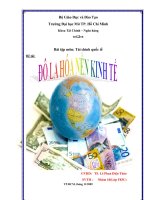bài giảng môn tài chính quốc tế the eurocurrency market
Bạn đang xem bản rút gọn của tài liệu. Xem và tải ngay bản đầy đủ của tài liệu tại đây (217.84 KB, 22 trang )
Truong Quang Thong
August 2012
! " # $
%$& '($)
Lecture 4 :
The Eurocurrency Market
1
*+,
Factor price differentials and trade barriers.
Arbitrage and the cost of capital.
Ownership advantages.
Income diversification.
Excess managerial capacity.
Location and the product life cycle.
2
-.
Physical presence through FDI.
Price differentials: cases of US and UK banks with subsidiaries in India; fund raisings by
Eurobanks,…
Trade barriers requiring banks to have a physical presence before they can start: case
of 100% foreign banks in Vietnam.
3
-
Arbitrage: the practice of taking advantage of price differentials between two or more
markets (See more on International Finance course).
The cost of capital: when a currency appreciates, banks find it easier to obtain finance in
this currency, causing more international banking…
4
"/-0
Natural disadvantages when entering a new market: new regulatory environment,
different customer demand,…
Possession of ownership advantages: superior marketing techniques, managerial
expertise, technival know-how,…
5
102
To diversify earnings, so to reduce risks.
Product diversification
Geographic diversification
6
31-
Banks face incentives to build up expertise in many areas even if this expertise would
not be required at present.
Given the present excess of managerial capacity, it is then efficient for banks to utilise
this capacity by entering a new geographical market.
7
#-
Unit Cost
Time
1
2 3
4
ACF
ACD
P=ARF
4 phase location cycle
8
"3-
Follow your customers.
Managerial motives
9
40
Money transmission and cash management.
Credit facilities with range of currencies.
Syndicated lending.
FX transactions and trade finance.
Bond issues.
Equity.
10
51
One of the truly significant innovations of international banking of the past 50 years.
Providing a foundation for a series of innovations in both structure and choices in the
financing of the MNCs.
11
+,
Size and dynamism of the economy
Size of official reserve assets
Importance of international trade
Size, depth and liquidity and openness of
domestic financial market
Convertibility
Soundness of macroeconomic policies
12
Eurocurrency are domestic currencies of one country on deposit in a second country.
Eurocurrency markets serve two valuable purposes:
An efficient and convenient monay market device for holding excess corporate liquidity;
Major source of short term bank loans to finance corporate working capital needs, including the
financing of imports and exports.
13
Banks which Eurocurrency are deposited are called Eurobanks.
Eurobank is a financial intermediary that simultaneously bids for time deposits and makes
loans in a currency other than that of the currency of the country in which it is located.
Eurocurrency operation that qualifies a bank for the name Eurobank is in fact a
department of a large commercial bank.
14
6
Born shortly after the WWII.
1945-1971: growing role of US$ as international means of payment and reserve asset: “$ as good as
gold…”.
The dollars of the Soviet Union and the creations of the two Soviet banks: Moscow Narodny Bank
in London and the Banque Commerciale pour l’Europe du Nord in Paris.
15
6
1957: restriction to UK bank lending in sterling to non-residents of the UK the choice of
dollar.
1960s: Expansion of US MNC in Western Europe. Many US banks set up oversea branches in
Europe.
International trading center in London:
Expertise of international monetary matters.
Proximity in time and distance to major customers.
16
6
Britain’s policy of GBP replacement by USD in
trade financing operations.
Balance of payment difficulties of the US during
1960s (hence increasing net US$ balance outside
the US).
1973 oil crisis and the petro-dollar.
17
6
Roots from the US banking regulations:
Regulation Q: interest rate ceilings on time deposits in the US
(1965-1966).
1963: Interest Equalization Tax imposed by the Fed to discourage US
investors from investing in foreign securities. Thus, non-US
borrowers had to sell securities outside the US market.
….
American banks have been able to make higher profits lending in
the Eurocurrency markets than in the domestic, highly regulated
market.
18
-6
Large international financial institutions: the WB,…
MNC
Goverments
Personal Investors
…
19
06
Low lending rates.
High borrowing rate.
Reasons of advantages:
Economy of scale
Admin cost savings
Highly qualified customers
Independence from supervisory and regulatory policies.
20
06
Competition among banks produces low lending margins.
Base rate: 6 month LIBOR + Spread
Spread: usually expressed in “basis point”.
21
."-6
Causing inflation?
FX risk?
Liquidity risk and the role of the lender of
last resort?
About a world supervisory and regulatory
framework?
22









